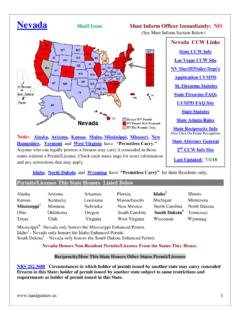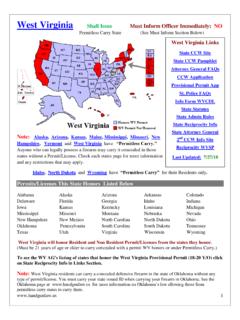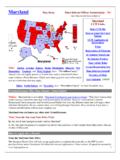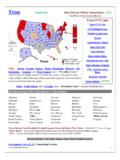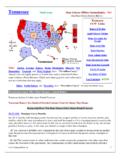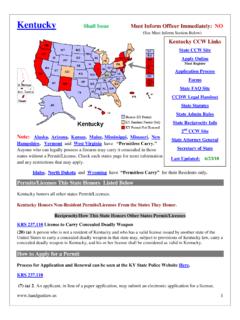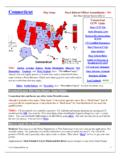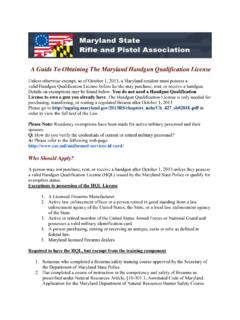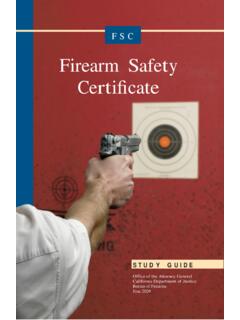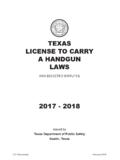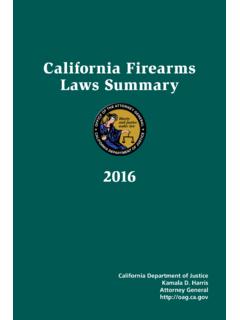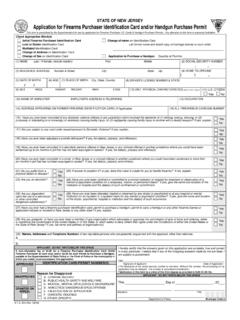Transcription of I. The Fundamentals of Firearm Safety - Handgunlaw.us
1 1 JOE ST SAUVER, Used with Permission I. The Fundamentals of Firearm Safety The three basic general rules of safe gun handling. 1. Always point the muzzle in a safe direction; never point a Firearm at anyone or anything you don't want to shoot. 2. Keep your finger off the trigger and outside the trigger guard until you are ready to shoot. 3. Keep the action open and the gun unloaded until you are ready to use it. II. Additional specific rules of safe gun handling Safety Rules Related to the Shooter and His Behavior.
2 1. Treat every Firearm as if it were loaded. 2. Never pass a Firearm to another person, or accept a Firearm from another person, until the cylinder or action is open and you've personally checked that the weapon is completely unloaded. 3. Before handling any Firearm , understand its operation. 4. Never rely on any mechanical device for Safety . 5. Think before shooting: once you pull the trigger you can't take back the shot you've just fired! 6. Never joke around or engage in horseplay while handling or using firearms. 7. Be alert at all times; never shoot if you're tired, cold or impaired in any way.
3 Don't mix alcohol or drugs with shooting. 8. Don't sleep with a loaded Firearm in your bedroom if you sleepwalk, have nightmares, sleep restlessly or have other sleep problems. 9. Safeguard your sight, hearing and health. Always wear eye and ear protection. Endeavor to limit your exposure to heavy metal particulates and gases, and minimize your contact with aromatic organic solvents (such as those commonly used in gun cleaning products). 10. If you see unsafe behavior any time when firearms are being handled or used, speak up and take action to correct the unsafe behavior at once.
4 11. Receive competent instruction from a qualified person before beginning to shoot. If questions arise later, after you've been shooting for a period of time, get answers to those questions from a competent authority. Safety Rules Related to Your Target. 1. Positively identify your target and the threat it poses before firing at it. 2. What's behind your target? Always make sure that a stray shot, or a bullet which penetrates its intended target through and through, will be safely stopped. 3. Never shoot at a hard surface, or at water -- your shot may glance off, ricochet and injure someone.
5 4. Never shoot at glass bottles, living trees, or inappropriate targets which would create a hazard for other persons or damage the environment. 2 5. Never shoot a rifle or handgun directly upwards, or at a high angle of elevation. Even a rimfire .22 bullet fired at an angle into the air can have enough energy a mile and a half away to accidentally kill someone! 6. Never shoot across a highway or other roadway. 7. Never vandalize a road sign (or other public or private property) by using it as a target.
6 8. Never poach a game animal out of season, or shoot any game animal you don't intend to eat. Safety Rules Related to Your Firearm . 1. Make sure your Firearm is in good mechanical condition before firing it. Periodically have your Firearm checked for signs of erosion, cracking, or wear by the factory, by a qualified armorer, or by a factory certified gunsmith. 2. Never try to fire a gun which may have a plugged or partially obstructed barrel. 3. Insure that any modifications made to a Firearm are made by a qualified individual, and that those modifications don't interfere with your Firearm 's Safety features.
7 4. Be sure all accessories, such as holsters and grips, are compatible with the Firearm and won't interfere with its safe operation. 5. Remember: a backup Firearm carried about your person may be highly valuable to you in the event your primary Firearm is ever rendered inoperable or is taken from you by an assailant. 6. It is your responsibility to insure that your Firearm is always either about your person and under your personal control, or positively secured from access by children or other unauthorized parties. Prevent tragedy: lock down your firearms when they aren't in use.
8 7. When storing a Firearm for a long period of time, consider storing the slide, bolt, or other critical components of the Firearm separately under separate lock and key. 8. Never carry a single action revolver with a round under the hammer unless that revolver is a modern transfer-bar type, equipped with an inertial firing pin. 9. Never carry a pistol with a round in the chamber unless the pistol has an automatic firing-pin block and/or an inertial firing pin. 10. Generally avoid carrying or storing an external hammer-type Firearm with its hammer cocked.
9 Exercise extreme care in decocking any external hammer Firearm : it is very easy to experience an accidental discharge while doing so if your thumb slips off the hammer. 11. Generally avoid unloading a Firearm by working the cartridges through the action one-at-a-time; drop the magazine and then eject the round which may be left in the chamber, instead, if possible. 12. Never use a scope mounted on a Firearm as a general purpose spotting scope: while observing an area you may end up accidentally aiming your Firearm at fellow hunters, or other non-targets.
10 13. Avoid trying to catch a live round (while unloading a semiautomatic pistol) by cupping your hand around the ejection port while retracting the slide; doing so may result in an accidental discharge. Safety Rules Related to Ammunition. 1. Be sure your gun and ammunition are compatible. Shooting incorrect ammunition in a Firearm may cause it to be damaged or even make it blow up. 2. Relying on ammunition which doesn't feed reliably in your particular Firearm may make your Firearm malfunction at a critical juncture: get experience with a particular lot of ammunition in your Firearm before relying on it for defensive purposes.
